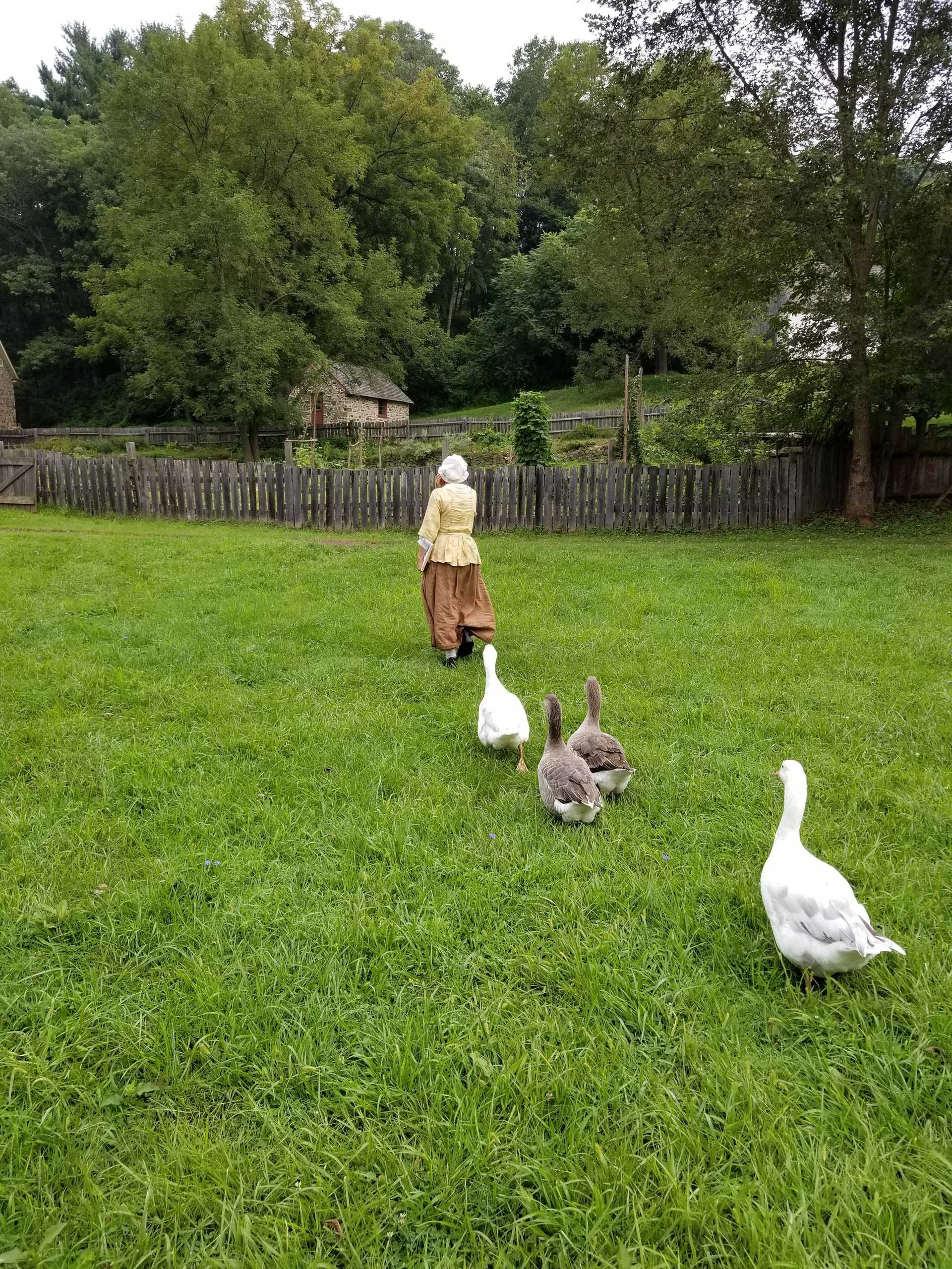- Home
- Visit
- Education
- Field Trips
- Summer Camps
Heritage Herd & Flock Fund
Support the Roots of Revolution—Farm Animals of the Founding Era
Our heritage breed animals are at the heart of every visitor's experience. From sheep and oxen to horses and birds, these animals bring our Revolutionary Era farm to life in the most tangible, memorable way.
Keeping our animals healthy and happy takes real care: daily feed and bedding, routine and emergency vet visits, medications, stall maintenance, and the attention of our dedicated farm team.
Your support feeds more than animals—it feeds curiosity, joy, and connection. All supporters receive a quarterly News From the Farm newsletter and a personal thank you note.
Become a Revolutionary Caretaker! Donate now and help us preserve the past, enrich the present, and inspire the future.
Double Your Impact
A generous donor has stepped forward with an incredible challenge for our community. If we can raise $5000 by December 31, every dollar will be matched. Give today and double your donation!
Birds
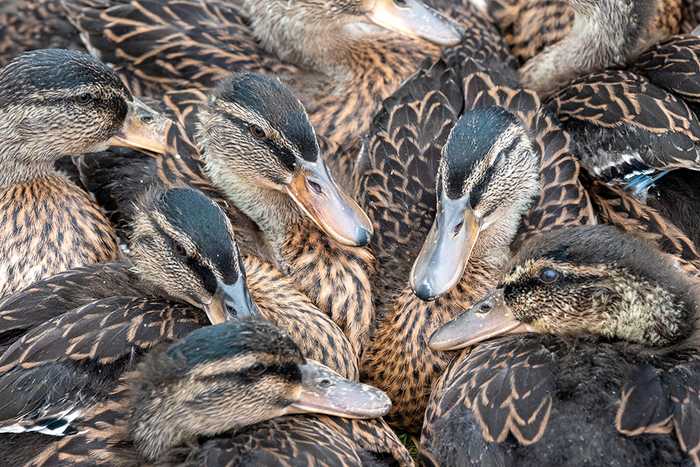
Chickens, Ducks, and Turkeys
$25 - Supporter
$250 - Caretaker
Help care for our feathered friends who play a vital role in colonial farm life providing eggs for our hearth cooks and feathers for quill pens.
Sheep
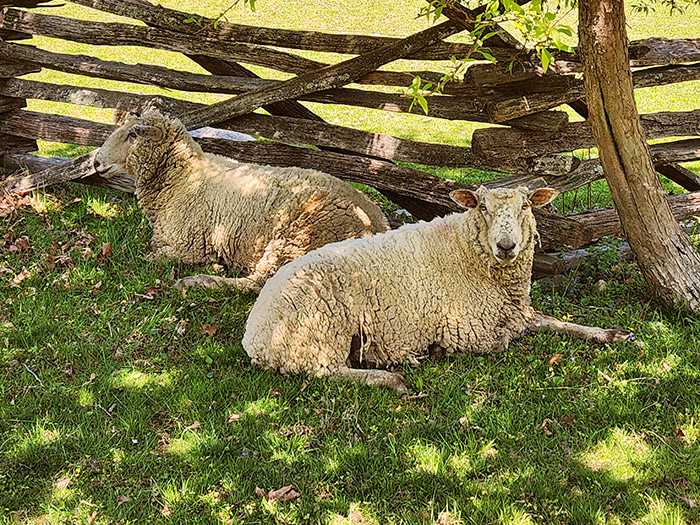
Heritage Breeds for Wool & Education
$50 - Supporter
$500 - Caretaker
Support our heritage sheep, whose wool is hand-processed on site using historic methods of carding, spinning, dyeing, and weaving.
*Caretaker-level Supporters receive 4 complimentary early access tickets to our spring sheep shearing event.
Horses
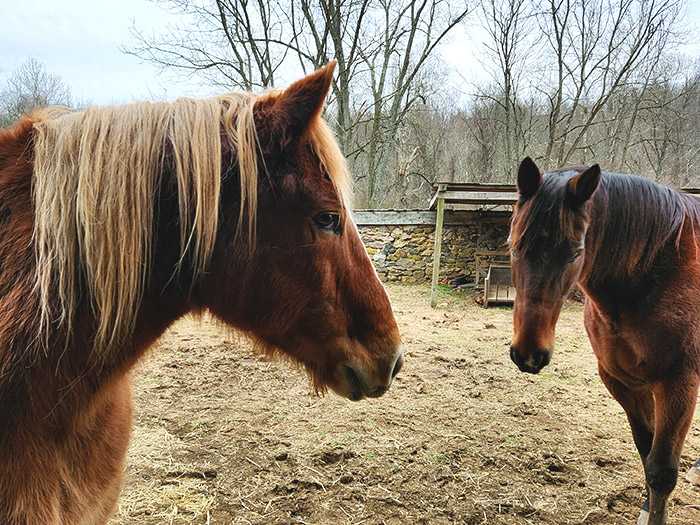
Essential for Farm Work and Transport
$100 - Supporter
$1,000 - Caretaker
Help feed and care for our beloved horses, key figures in fieldwork and transportation of the 18th century.
*Caretaker-level Supporters are invited to a special behind-the-scenes visit. You'll get hands-on experience with the daily care of our horses and a chance to meet them up close.
Oxen
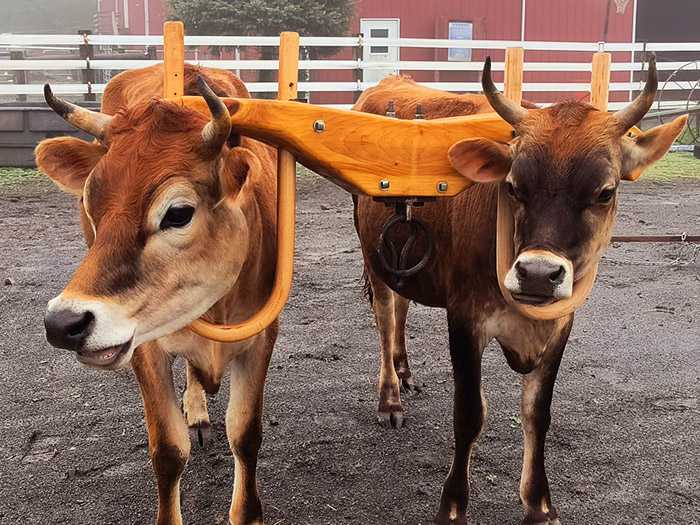
The Muscle of the Colonial Farm
$150 - Supporter
$1,500 - Caretaker
Support the powerful oxen that demonstrate the strength and skill behind early American farming.
*Caretaker-level Supporters enjoy a behind-the-scenes session to learn about ox driving and training. It's a rare hands-on experience with the animals that powered early American farms.
Help the Farmstead right away by donating an item from our Amazon and Tractor Supply wishlists!
Your support makes a real difference.While symbolic, your donation directly impacts the daily care and well-being of all our animals. This includes everything from feed and bedding to veterinary visits, medications, shelter upkeep, and even the hard work of our dedicated farm staff who care for them every day. Your gift helps keep the barn doors open, the pastures green, and our animals happy, healthy, and thriving. All levels receive quarterly News on the Farm newsletter and personal thank you note.
Colonial Farmstead's Heritage Breed Program
Heritage Breeds
"Heritage breeds are traditional livestock breeds that were raised by our forefathers. These are the breeds of a bygone era, before industrial agriculture became a mainstream practice" (The Livestock Conservancy).
CPF’s first heritage-breed animals arrived in 1974, even before our site opened officially to the public, and staff have continued the tradition of historic animal husbandry. Heritage-breed animals represent a slice of the earth’s biodiversity that cannot be replaced. Many of these breeds evolved in the face of harsh climates and retain essential attributes for survival including unparalleled mothering and foraging instincts, and disease resistance. They are vital for ensuring the future of food security all over the world.
In addition to having heritage-breed animals, CPF also helps preserve some critically endangered breeds like Hog Island sheep and threatened breeds like Leicester Longwool Sheep.
Milking Shorthorn: Rust
Shorthorns are considered one of the most influential breeds in agricultural history. First imported to America in 1783, these versatile cattle were highly valued by early American farmers as a true triple-purpose breed—providing meat, milk, and muscle for draft work. Their adaptability made them a cornerstone of 18th- and 19th-century farm life.
By the 1800s, Shorthorns began to lose prominence in dairy production to the high-yielding Holstein. Over time, the breed split into two distinct groups: Beef Shorthorns and Milking Shorthorns, the latter of which has become increasingly rare and is now considered a heritage breed.
Our Milking Shorthorn, Rust, is a striking representative of the breed’s strength and stature. Through generations of selective breeding, modern Shorthorns have grown much larger than their colonial ancestors—Rust is nearly twice the size of an 18th-century ox. His impressive frame often draws gasps from visitors, and we imagine a colonial farmer would have had the same reaction: “He’s massive!”
Jersey Cattle: Bean & Diesel
Small in size but mighty in personality and production, Jersey cattle have been beloved by farmers for centuries. Originating from the British Channel Island of Jersey, they were first imported to America in the early 1800s and quickly gained popularity for their exceptionally rich milk, high in butterfat—perfect for making cream, butter, and cheese on the farm.
Unlike larger breeds, Jerseys are known for their gentle nature, intelligence, and agility, making them ideal for smaller farms and hand milking. Their smaller stature also means they require less feed and space, all while producing high-quality milk—a true example of efficiency in heritage livestock.
With their big eyes and curious nature, our Jerseys, Bean and Diesel, make them natural ambassadors for 18th-century dairy life. While Jerseys were not the dominant breed in colonial Pennsylvania (that title went to Shorthorns and native mixes), their rise in the 19th century makes them an important part of the evolving story of American dairying.
Soay Sheep
Soay sheep are likely the oldest surviving breed of sheep in the world, offering a living window into what sheep looked like thousands of years ago—long before selective breeding shaped the modern flocks we know today. These hardy, primitive sheep have changed remarkably little since the Bronze Age, when it’s believed they were brought to the remote St. Kilda archipelago off the northwest coast of Scotland.
For centuries, every Soay sheep in existence lived on the island of Soay—a name that comes from Old Norse for “sheep island.” When Vikings arrived a thousand years ago, they found sheep already there, grazing the windswept, treeless rock. How they got there remains a mystery—but their survival in a place where winter winds can reach 200 miles per hour is a testament to their toughness.
Despite their small size—only 50–60 lbs.—Soays are incredibly agile, fast, and strong. One Soay can easily leap a six-foot fence. They shed their wool naturally, don’t require shearing, and come in a range of earthy colors from deep brown to pale fawn, often with distinctive white markings on the belly, legs, and face. Most Soays have horns, both rams and ewes, though some are naturally polled.
Hog Island Sheep
Hog Island sheep are a critically endangered heritage breed with a wild story to tell. Originally brought to America in the 1700s, these sheep were turned loose—or escaped—onto Hog Island, a remote barrier island off the coast of Virginia. Isolated from predators and people for generations, they adapted to survive without human help, becoming one of the few truly feral sheep breeds in American history.
Unlike breeds carefully refined for wool or temperament, Hog Islands were shaped by natural selection—not human design. Their wool is short and coarse, not ideal for spinning, and in the wild they’ll shed it naturally each spring. They are also naturally wary of people and skittish by nature, a behavior that helped them survive the island’s storms and sparse conditions.
Most Hog Island sheep are cream-colored with dark faces and legs, but about 10% are completely black, like our striking residents Ophelia and Gus. They typically weigh around 120 lbs, and both rams and ewes may have horns—or be hornless, known as “polled.”
Though they originated in the colonial period, Hog Island sheep were never common in Pennsylvania and weren’t typically kept on 18th-century farms. Still, they offer an important contrast to the domesticated breeds of the time and help us tell the broader story of livestock in early America and the consequences of isolation, survival, and adaptation.
Today, only about 200 registered Hog Island sheep remain worldwide. Ours came from George Washington’s Mount Vernon, one of the few places actively working to preserve the breed.
Horned Dorset Sheep
Horned Dorsets are a historic English breed known for their strength, adaptability, and unique reproductive ability. Found throughout southwest England since the Middle Ages, Dorsets were developed as a dual-purpose sheep, valued both for their flavorful meat and their dense, white fleece.
One of the Dorset’s most distinctive and valuable traits is its extended breeding season, a rarity among sheep. While most breeds only breed in the fall and lamb in the spring, Dorsets can breed year-round, allowing farmers to plan for fall lambs, or even support two lambing seasons in a single year. This makes them especially prized by traditional farmers and shepherds who need a consistent supply of lambs throughout the year.
Dorsets were introduced to the United States around 1860, where they quickly gained popularity. While both horned and polled (hornless) lines exist, the Horned Dorset is the original form of the breed and a key part of agricultural history.
At the Farmstead, our Horned Dorsets help tell the story of British livestock influence on American farms and the changing nature of animal husbandry through the 18th and 19th centuries. Their classic white faces and sturdy frames make them a visual icon of traditional sheep farming
Leicester Longwool Sheep
Leicester Longwool
Our trio of Leicester Longwool sheep—Violet, Franklin, and Marshall—represent one of the most important turning points in agricultural history. While breeds like the Hog Island sheep evolved with little human interference, Leicesters are the product of the first truly scientific breeding program, making them a landmark in the story of modern farming.
In the mid-1700s, English agriculturalist Robert Bakewell revolutionized livestock breeding by applying early genetic principles to selectively develop animals with desired traits. His most famous success was the Leicester Longwool, prized for its dual-purpose use: long, lustrous wool and high-quality meat. Bakewell’s innovations didn’t just change sheep—his work influenced the thinking of Charles Darwin and Gregor Mendel, and captured the attention of American Founders: George Washington and Thomas Jefferson both kept Leicesters on their farms at Mount Vernon and Monticello.
Leicester Longwools are known for their beautiful, curly fleece, beloved by fiber artists for its length, strength, and shine. They are also easy keepers with a tendency to gain weight easily, reflecting their development as a meat breed. All Leicesters are naturally polled (hornless).
Our ewe Violet was born in 2017 at Greenbank Mill in Delaware, while Franklin and Marshall, both born in March 2020, came from Colonial Williamsburg, which played a major role in reintroducing the breed to North America in 1990 by importing Leicesters from Australia.
Chicken Breeds
Dominique
The Dominique is widely recognized as the first chicken breed developed in America. Though its exact origin is uncertain, the name may come from Saint Dominique (modern-day Haiti), suggesting Caribbean roots. Dominiques are calm, gentle birds who are excellent foragers, making them ideal for free-ranging colonial farms.
Hamburg
Hamburgs are lively, energetic chickens with a long history that stretches back to 14th-century Holland—and maybe even to the first-ever chicken show in England! These birds are known for their tendency to roost in trees, avoid predators, and never stay still.
Silver Dorking
With their distinctive five toes (most chickens have four!), the Silver Dorking may trace its lineage back to ancient Rome. Famous for their flavor and size, Dorkings were an ideal farm chicken, often raised for both eggs and meat. They prefer to free-range, just like they would have on an 18th-century English farm.
Nankin
Nankins are one of the oldest true bantam breeds, meaning they have no larger counterpart. These small chickens were popular in 18th-century Britain and Colonial America, known especially for their extreme broodiness. Historically, Nankins were used to hatch eggs for game birds like pheasants and partridges.
Bourbon Red Turkey
Our handsome turkey, Tom, is a Bourbon Red, a breed developed in Bourbon County, Kentucky. These striking birds were once favored for their rich flavor and striking chestnut-red feathers. Born in August 2022, Tom is both a living piece of agricultural history and a star of the poultry yard.
Mallard Ducks
Mallards are the most recognizable and widespread ducks in the world—and the wild ancestor of nearly every domestic duck breed. With their signature green-headed drakes and softly patterned hens, Mallards have long played a role on farms and in wetlands alike.
While not typically raised for eggs or meat on a large scale in colonial America, Mallards would have been a familiar sight near ponds and streams, and may have been kept in small numbers for their eggs or to help control insects. Hardy and resourceful, Mallards are excellent foragers and enjoy open water and freedom to roam.
